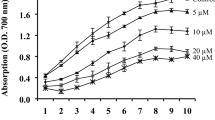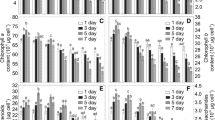Abstract
To evaluate the removal of potassium cyanide (KCN) and its toxicity in algae, an initial comprehensive analysis was performed with Chlorella vulgaris. The algae showed potential removal capability for KCN, with the maximal removal rate of 61%. Moreover, effects of KCN on growth, cellular morphology and antioxidant defense system of C. vulgaris were evaluated. Cell number and chlorophyll a content decreased in most cases, with the maximal inhibition rates of 48% and 99%, respectively. The 100 mg L− 1 KCN seriously damaged the algal cell membrane. Additionally, activity of superoxide dismutase (SOD) was promoted by KCN exposure among 0.1–50 mg L− 1 and inhibited by 100 mg L− 1 KCN, while the malondialdehyde (MDA) content gradually decreased in C. vulgaris with increasing exposure concentration compared to the control. The present study reveals that C. vulgaris is useful in bio-treatment of cyanide-contaminated aquatic ecosystem, except in high concentrations which would cause overwhelming effects.




Similar content being viewed by others
References
Adams DJ, Komen JV, Pickett TM (2001) Biological cyanide degradation. In Young C (ed) Cyanide: social, industrial and economic aspects. The Metals Society, Pittsburgh, pp 203–213
Akcil A (2003) Destruction of cyanide in gold mill effluents: biological versus chemical treatments. Biotechnol Adv 21:501–511
Akcil A, Mudder T (2003) Microbial destruction of cyanide wastes in gold mining: process review. Biotechnol Lett 25:445–450
Akcil A, Karahan AG, Ciftci H, Sagdic O (2003) Biological treatment of cyanide by natural isolated bacteria (Pseudomonas sp). Mineral Eng 16:643–649
Arellano CAP, Martínez SS (2007) Indirect electrochemical oxidation of cyanide by hydrogen peroxide generated at a carbon cathode. Int J Hydrogen Energy 32:3163–3169
Bowler C, Montagu MV, Inze D (1992) Superoxide dismutase and stress tolerance. Annu Rev Plant Biol 43:83–116
Dash RR, Gaur A, Balomajumder C (2009) Cyanide in industrial waste-waters and its removal: a review on biotreatment. J Hazard Mater 163:1–11
Editorial Committee of Ministry Environmental protection of China (2002) Methods of water and waste water monitoring and analysis. 4th edn. China Environment and Science Publisher, Beijing
Essam T, ElRakaiby M, Agha A (2014) Remediation of the effect of adding cyanides on an algal/bacterial treatment of a mixture of organic pollutants in a continuous photobioreactor. Biotechnol Lett 36:1773–1781
Gurbuz F, Ciftci H, Akcil A, Karahan AG (2004) Microbial detoxification of cyanide solutions: a new biotechnological approach using algae. Hydrometallurgy 72:167–176
Jin ZP, Luo K, Zhang S, Zheng Q, Yang H (2012) Bioaccumulation and catabolism of prometryne in green algae. Chemosphere 87:278–284
Kelada NP (1989) Automated direct measurements of total cyanide species and thiocyanate, and their distribution in wastewater and sludge. J Water Pollut Control Fed 61:350–356
Kenfield CF, Qin R, Semmens MJ, Cussler EL (1988) Cyanide recovery across hollow fiber gas membranes. Environ Sci Technol 22:1151–1155
Li R, Chen GZ, Tam NFY, Luan TG, Shin PK, Cheung SG, Liu Y (2009) Toxicity of bisphenol A and its bioaccumulation and removal by a marine microalga Stephanodiscus hantzschii. Ecotoxicol Environ Saf 72:321–328
Liu J, Sun Z, Lavoie M, Fan X, Bai X, Qian H (2015) Ammonium reduces chromium toxicity in the freshwater alga Chlorella vulgaris. Appl Microbiol Biotechnol 99:3249–3258
Lordi DT, Lue-Hing C, Whitebloom SW, Kelada N, Dennison S (1980) Cyanide problems in municipal wastewater treatment plants. J Water Pollut Control Fed 52:597–609
Manar R, Bonnard M, Rast C, Veber A, Vasseur P (2011) Ecotoxicity of cyanide complexes in industrially contaminated soils. J Hazard Mater 197:369–377
Ministry Environmental Protection of China (2009) Water quality-determination of cyanide-volumetric and spectrophotometry method (HJ484-2009) Available at http://kjs.mep.gov.cn/hjbhbz/bzwb/shjbh/sjcgfffbz/200910/W020111114532654963447.pdf. (In Chinese)
Mittler R (2002) Oxidative stress, antioxidants and stress tolerance. Trends Plant Sci 7:405–410
Moreno-Garrido I, Lubián LM, Soares AMVM (2000) Influence of cellular density on determination of EC50 in microalgal growth inhibition tests. Ecotoxicol Environ Saf 47:112–116
Novak D, Franke-Whittle IH, Pirc ET, Jerman V, Insam H, Logar RM, Stres B (2013) Biotic and abiotic processes contribute to successful anaerobic degradation of cyanide by UASB reactor biomass treating brewery waste water. Water Res 47:3644–3653
Pitanga FL (2011) The effect of sodium hypochlorite in different aquatic organisms. Dissertation, University of Aveiro, 20
Rashkov GD, Dobrikova AG, Pouneva ID, Misra AN, Apostolova EL (2012) Sensitivity of Chlorella vulgaris to herbicides. Possibility of using it as a biological receptor in biosensors. Sens Actuators B 161:151–155
Shang YZ, Qin BW, Cheng JJ, Miao H (2008) Effect of Scutellaria falvonoids on KCN-induced damages in rat pheochromocytoma PC12 cells. Indian J Med Res 127:610
Soldán P, Pavonič M, Bouček J, Kokeš J (2001) Baia Mare accident—brief ecotoxicological report of Czech experts. Ecotoxicol Environ Saf 49:255–261
Song NH, Yin X, Chen GF, Yang H (2007) Biological responses of wheat (Triticum aestivum) plants to the herbicide chlorotoluron in soils. Chemosphere 69:1779–1787
Tarras-Wahlberg NH, Flachier A, Lane SN, Sangfors O (2001) Environmental impacts and metal exposure of aquatic ecosystems in rivers contaminated by small scale gold mining: the Puyango River basin, southern Ecuador. Sci Total Environ 278:239–261
Valavanidis A, Vlahogianni T, Dassenakis M, Scoullos M (2006) Molecular biomarkers of oxidative stress in aquatic organisms in relation to toxic environmental pollutants. Ecotoxicol Environ Saf 64:178–189
Wu GL, Cui J, Tao L, Yang H (2010) Fluroxypyr triggers oxidative damage by producing superoxide and hydrogen peroxide in rice (Oryza sativa). Ecotoxicology 19:124–132
Xiong B, Zhang W, Chen L, Lin KF, Guo MJ, Wang WL, Cui XH, Bi HS, Wang B (2014) Effects of Pb (II) exposure on Chlorella protothecoides and Chlorella vulgaris growth, malondialdehyde, and photosynthesis-related gene transcription. Environ Toxicol 29:1346–1354
Yin XL, Jiang L, Song NH, Yang H (2008) Toxic reactivity of wheat (Triticum aestivum) plants to herbicide isoproturon. J Agric Food Chem 56:4825–4831
Zhang S, Qiu CB, Zhou Y, Jin ZP, Yang H (2011) Bioaccumulation and degradation of pesticide fluroxypyr are associated with toxic tolerance in green alga Chlamydomonas reinhardtii. Ecotoxicology 20:337–347
Acknowledgements
This study was supported by the basic research project of the State Key Laboratory of NBC Protection for Civilian of China and the Fundamental Research Funds for the Central Universities (KYLX16_0810).
Author information
Authors and Affiliations
Corresponding author
Rights and permissions
About this article
Cite this article
Liu, Q., Zhang, G., Ding, J. et al. Evaluation of the Removal of Potassium Cyanide and its Toxicity in Green Algae (Chlorella vulgaris). Bull Environ Contam Toxicol 100, 228–233 (2018). https://doi.org/10.1007/s00128-017-2208-1
Received:
Accepted:
Published:
Issue Date:
DOI: https://doi.org/10.1007/s00128-017-2208-1




